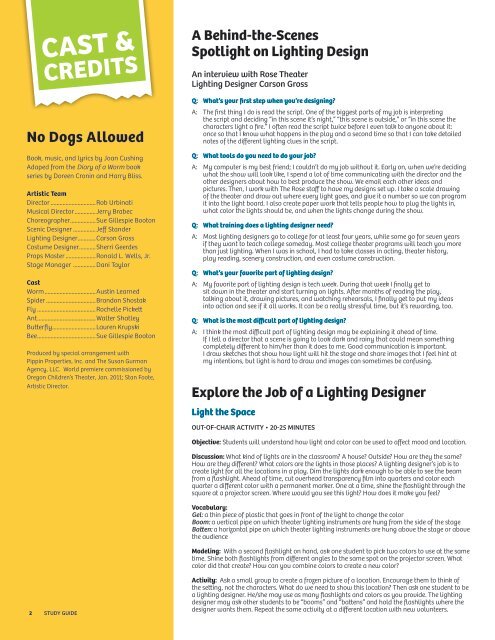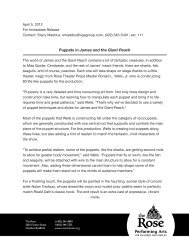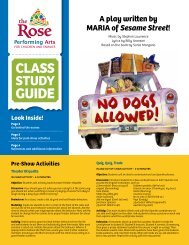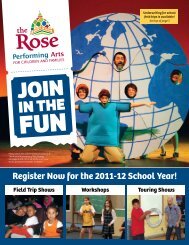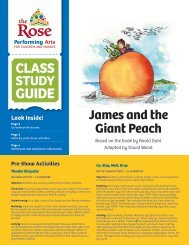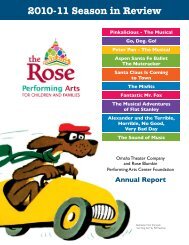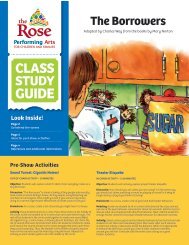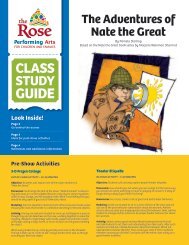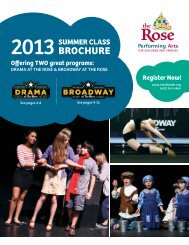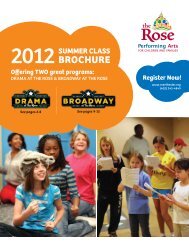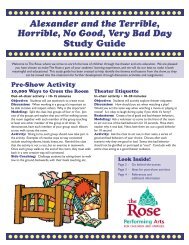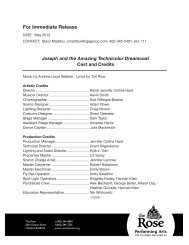Diary of a Worm, a Spider, and a Fly - The Music Hall
Diary of a Worm, a Spider, and a Fly - The Music Hall
Diary of a Worm, a Spider, and a Fly - The Music Hall
You also want an ePaper? Increase the reach of your titles
YUMPU automatically turns print PDFs into web optimized ePapers that Google loves.
A Behind-the-Scenes<br />
Spotlight on Lighting Design<br />
An interview with Rose <strong>The</strong>ater<br />
Lighting Designer Carson Gross<br />
No Dogs Allowed<br />
Book, music, <strong>and</strong> lyrics by Joan Cushing<br />
Adaped from the <strong>Diary</strong> <strong>of</strong> a <strong>Worm</strong> book<br />
series by Doreen Cronin <strong>and</strong> Harry Bliss.<br />
Artistic Team<br />
Director...............................Rob Urbinati<br />
<strong>Music</strong>al Director...............Jerry Brabec<br />
Choreographer..................Sue Gillespie Booton<br />
Scenic Designer................Jeff St<strong>and</strong>er<br />
Lighting Designer.............Carson Gross<br />
Costume Designer............Sherri Geerdes<br />
Props Master.....................Ronald L. Wells, Jr.<br />
Stage Manager ................Dani Taylor<br />
Cast<br />
<strong>Worm</strong>...................................Austin Learned<br />
<strong>Spider</strong>..................................Br<strong>and</strong>on Shostak<br />
<strong>Fly</strong>........................................Rochelle Pickett<br />
Ant........................................Walter Shatley<br />
Butterfly..............................Lauren Krupski<br />
Bee........................................Sue Gillespie Booton<br />
Produced by special arrangement with<br />
Pippin Properties, Inc. <strong>and</strong> <strong>The</strong> Susan Gurman<br />
Agency, LLC. World premiere commissioned by<br />
Oregon Children’s <strong>The</strong>ater, Jan. 2011; Stan Foote,<br />
Artistic Director.<br />
Q: What’s your first step when you’re designing?<br />
A: <strong>The</strong> first thing I do is read the script. One <strong>of</strong> the biggest parts <strong>of</strong> my job is interpreting<br />
the script <strong>and</strong> deciding “in this scene it’s night,” “this scene is outside,” or “in this scene the<br />
characters light a fire.” I <strong>of</strong>ten read the script twice before I even talk to anyone about it:<br />
once so that I know what happens in the play <strong>and</strong> a second time so that I can take detailed<br />
notes <strong>of</strong> the different lighting clues in the script.<br />
Q: What tools do you need to do your job?<br />
A: My computer is my best friend; I couldn’t do my job without it. Early on, when we’re deciding<br />
what the show will look like, I spend a lot <strong>of</strong> time communicating with the director <strong>and</strong> the<br />
other designers about how to best produce the show. We email each other ideas <strong>and</strong><br />
pictures. <strong>The</strong>n, I work with <strong>The</strong> Rose staff to have my designs set up. I take a scale drawing<br />
<strong>of</strong> the theater <strong>and</strong> draw out where every light goes, <strong>and</strong> give it a number so we can program<br />
it into the light board. I also create paper work that tells people how to plug the lights in,<br />
what color the lights should be, <strong>and</strong> when the lights change during the show.<br />
Q: What training does a lighting designer need?<br />
A: Most lighting designers go to college for at least four years, while some go for seven years<br />
if they want to teach college someday. Most college theater programs will teach you more<br />
than just lighting. When I was in school, I had to take classes in acting, theater history,<br />
play reading, scenery construction, <strong>and</strong> even costume construction.<br />
Q: What’s your favorite part <strong>of</strong> lighting design?<br />
A: My favorite part <strong>of</strong> lighting design is tech week. During that week I finally get to<br />
sit down in the theater <strong>and</strong> start turning on lights. After months <strong>of</strong> reading the play,<br />
talking about it, drawing pictures, <strong>and</strong> watching rehearsals, I finally get to put my ideas<br />
into action <strong>and</strong> see if it all works. It can be a really stressful time, but it’s rewarding, too.<br />
Q: What is the most difficult part <strong>of</strong> lighting design?<br />
A: I think the most difficult part <strong>of</strong> lighting design may be explaining it ahead <strong>of</strong> time.<br />
If I tell a director that a scene is going to look dark <strong>and</strong> rainy that could mean something<br />
completely different to him/her than it does to me. Good communication is important.<br />
I draw sketches that show how light will hit the stage <strong>and</strong> share images that I feel hint at<br />
my intentions, but light is hard to draw <strong>and</strong> images can sometimes be confusing.<br />
Explore the Job <strong>of</strong> a Lighting Designer<br />
Light the Space<br />
OUT-OF-CHAIR ACTIVITY • 20-25 MINUTES<br />
Objective: Students will underst<strong>and</strong> how light <strong>and</strong> color can be used to affect mood <strong>and</strong> location.<br />
Discussion: What kind <strong>of</strong> lights are in the classroom? A house? Outside? How are they the same?<br />
How are they different? What colors are the lights in those places? A lighting designer’s job is to<br />
create light for all the locations in a play. Dim the lights dark enough to be able to see the beam<br />
from a flashlight. Ahead <strong>of</strong> time, cut overhead transparency film into quarters <strong>and</strong> color each<br />
quarter a different color with a permanent marker. One at a time, shine the flashlight through the<br />
square at a projector screen. Where would you see this light? How does it make you feel?<br />
Vocabulary:<br />
Gel: a thin piece <strong>of</strong> plastic that goes in front <strong>of</strong> the light to change the color<br />
Boom: a vertical pipe on which theater lighting instruments are hung from the side <strong>of</strong> the stage<br />
Batten: a horizontal pipe on which theater lighting instruments are hung above the stage or above<br />
the audience<br />
Modeling: With a second flashlight on h<strong>and</strong>, ask one student to pick two colors to use at the same<br />
time. Shine both flashlights from different angles to the same spot on the projector screen. What<br />
color did that create? How can you combine colors to create a new color?<br />
2 STUDY GUIDE<br />
Activity: Ask a small group to create a frozen picture <strong>of</strong> a location. Encourage them to think <strong>of</strong><br />
the setting, not the characters. What do we need to show this location? <strong>The</strong>n ask one student to be<br />
a lighting designer. He/she may use as many flashlights <strong>and</strong> colors as you provide. <strong>The</strong> lighting<br />
designer may ask other students to be “booms” <strong>and</strong> “battens” <strong>and</strong> hold the flashlights where the<br />
designer wants them. Repeat the same activity at a different location with new volunteers.


